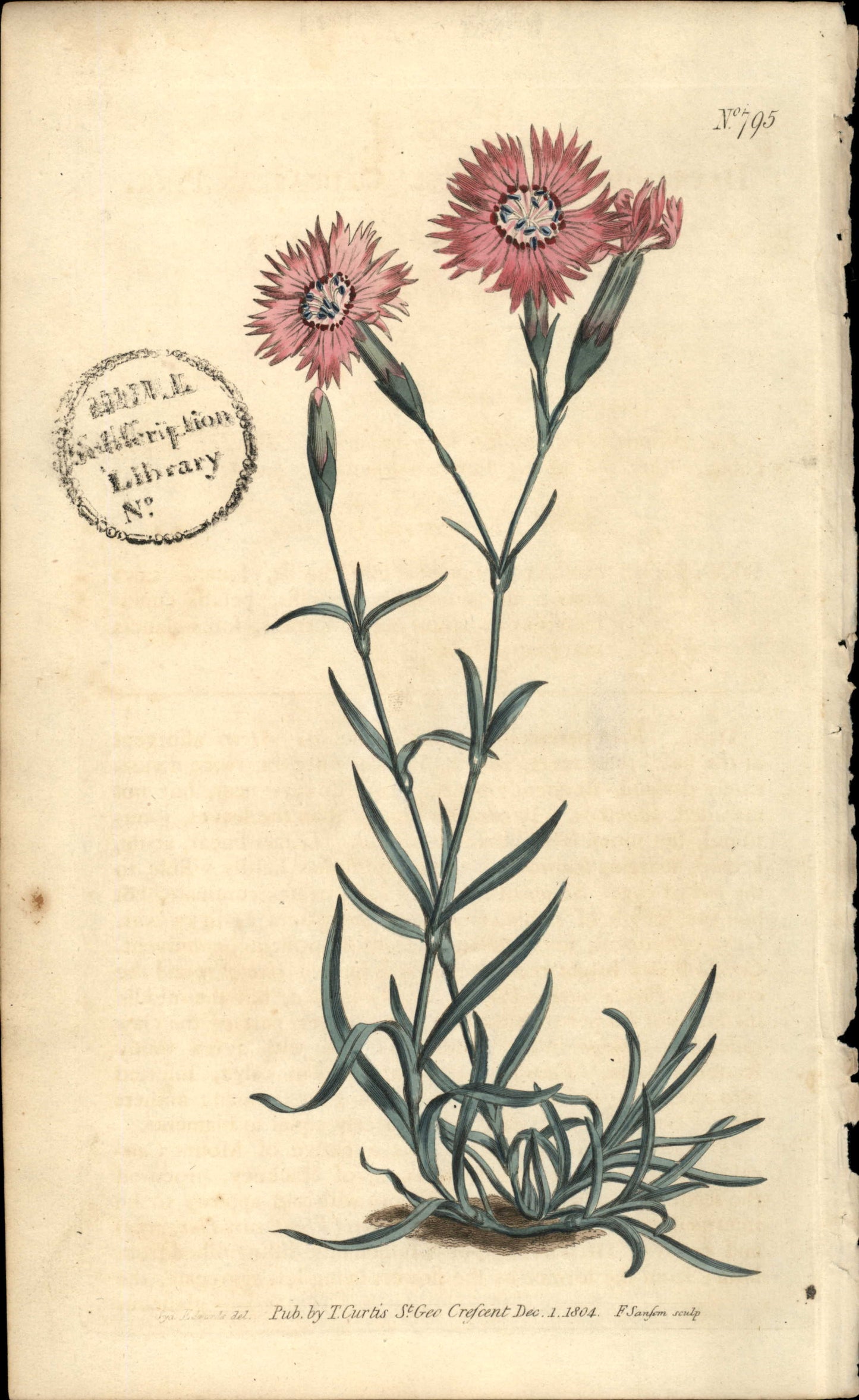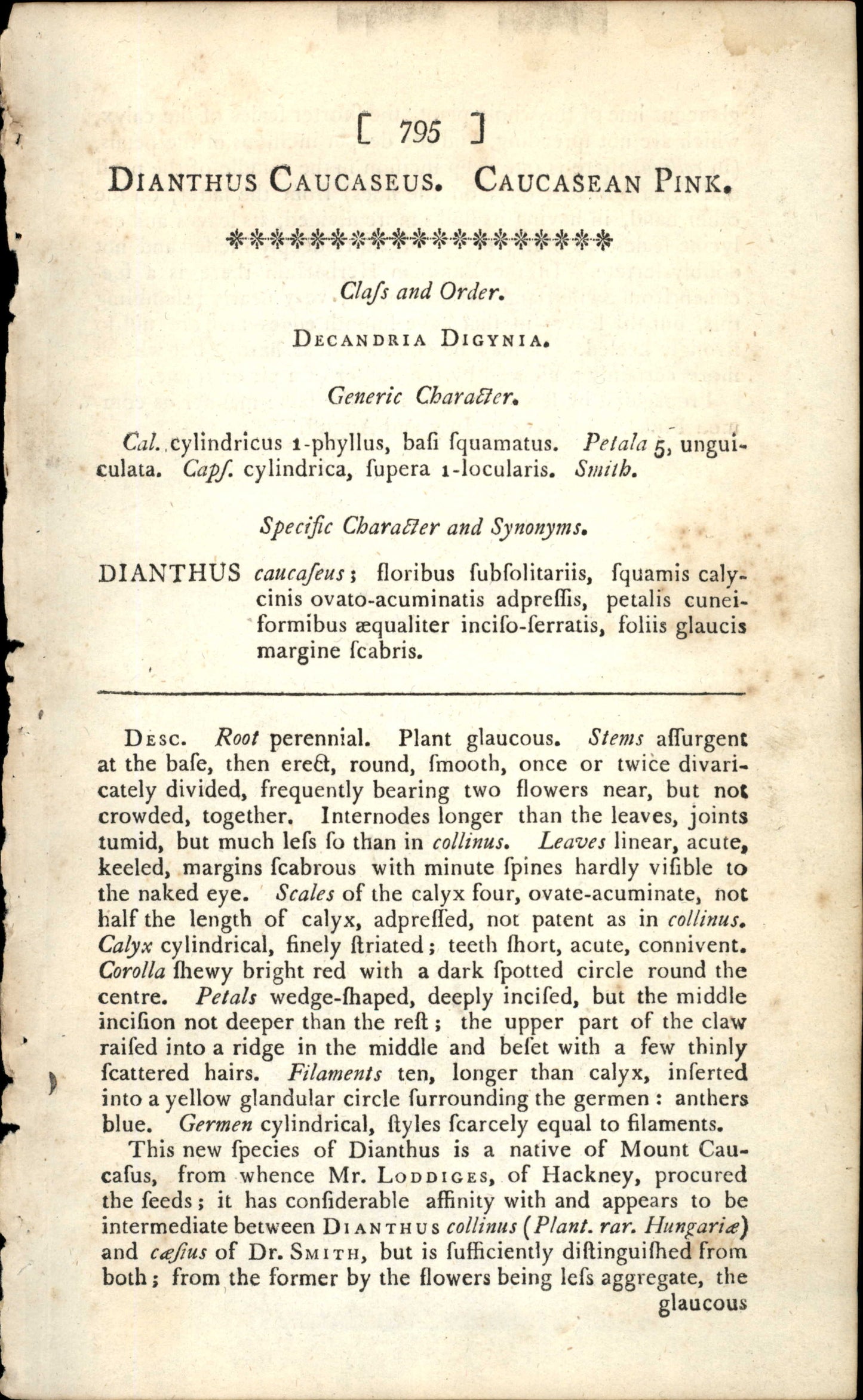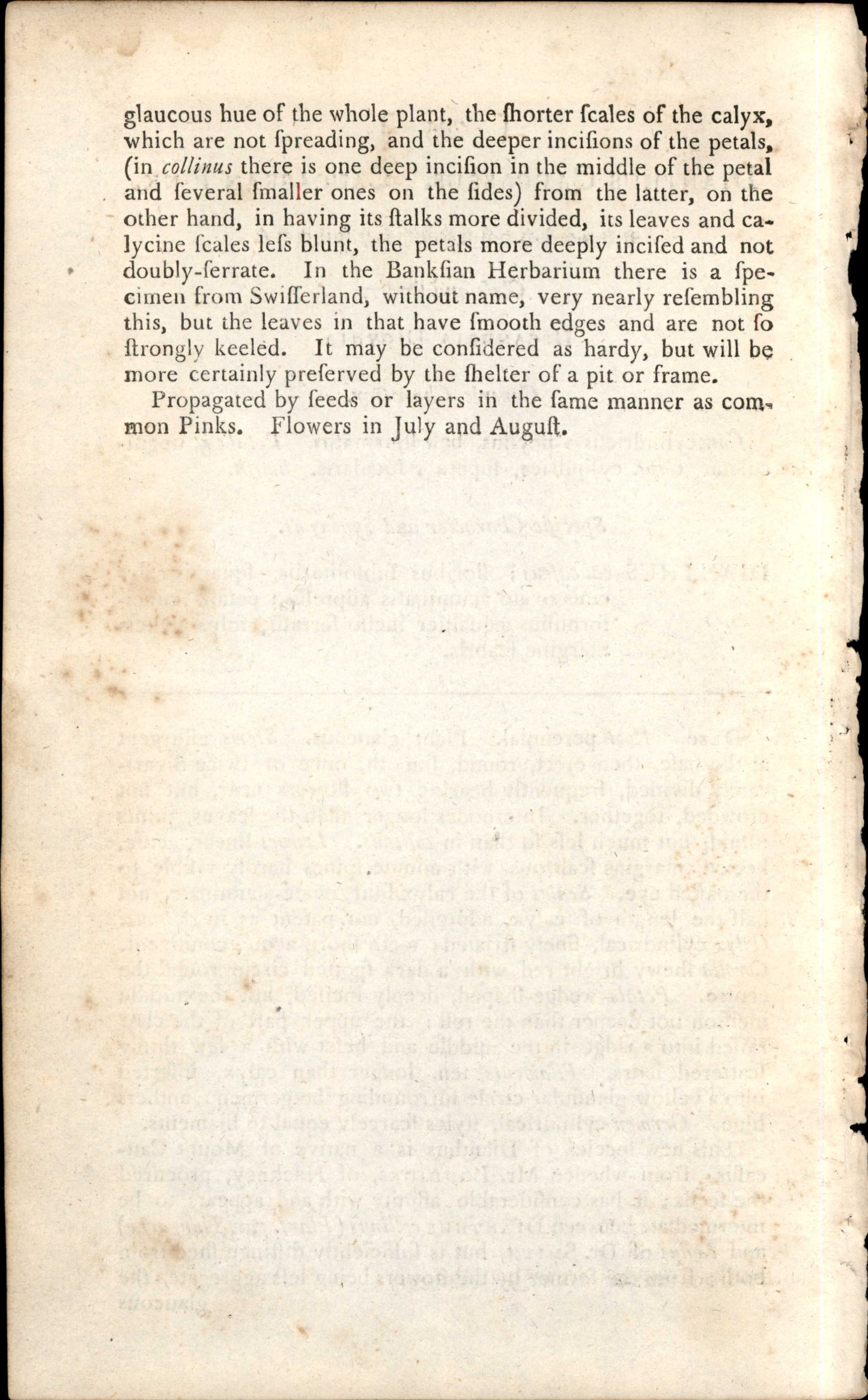Curtis Botanical Magazine
Plate 795 - Dianthus Caucaseus
Plate 795 - Dianthus Caucaseus
Couldn't load pickup availability
Plate 795
Classification: DECANDRIA DIGYNIA
Flowering Period: May - July - August
Publication Date: Dec 1, 1804
Description:
Complete Botanical Text (Cleaned)
[ 795 ] DIANTHUS CAUCASEUS. ******** CAUCASEAN PINK. ****** Class and Order.
DECANDRIA DIGYNIA.
Generic Character.
Cal. cylindricus 1-phyllus, basi fquamatus.
Petala 5, ungui- culata.
Capf. cylindrica, fupera 1-locularis. smith. specific Character and synonyms.
DIANTHUS caucafeus; floribus fubsolitariis, fquamis caly- cinis ovato-acuminatis adpreffis, petalis cunei- formibus æqualiter inciso-ferratis, soliis glaucis margine fcabris.
DEsC.
Root perennial.
Plant glaucous. stems affurgent at the base, then erect, round, smooth, once or twice divari- cately divided, frequently bearing two flowers near, but not crowded, together.
Internodes longer than the leaves, joints tumid, but much less so than in collinus.
Leaves linear, acute, keeled, margins fcabrous with minute fpines hardly vifible to the naked eye. scales of the calyx four, ovate-acuminate, not half the length of calyx, adpreffed, not patent as in collinus.
Calyx cylindrical, finely ftriated; teeth short, acute, connivent.
Corolla showy bright red with a dark spotted circle round the centre.
Petals wedge-shaped, deeply incifed, but the middle incifion not deeper than the reft; the upper part of the claw raised into a ridge in the middle and beset with a few thinly scattered hairs.
Filaments ten, longer than calyx, inserted into a yellow glandular circle surrounding the germen: anthers blue.
Germen cylindrical, ftyles scarcely equal to filaments.
This new species of Dianthus is a native of Mount Cau- cafus, from whence Mr.
LODDIGES, of Hackney, procured the seeds; it has considerable affinity with and appears to be intermediate between DIANTHUS collinus (Plant. rar.
Hungaria) and cæfius of Dr. sMITH, but is sufficiently distinguished from both; from the former by the flowers being less aggregate, the glaucous Setifeription Library N: yad del Pub. by TCurtis sGeo Crefcent Dec. 1.1804.
FSanfem sculp No795 glaucous hue of the whole plant, the shorter fcales of the calyx, which are not fpreading, and the deeper incifions of the petals, (in collinus there is one deep incifion in the middle of the petal and several smaller ones on the fides) from the latter, on the other hand, in having its stalks more divided, its leaves and ca- lycine fcales less blunt, the petals more deeply incifed and not doubly-ferrate.
In the Banksian Herbarium there is a spe- cimen from swifferland, without name, very nearly refembling this, but the leaves in that have smooth edges and are not so strongly keeled.
It may be confidered as hardy, but will be more certainly preserved by the shelter of a pit or frame.
Propagated by seeds or layers in the same manner as com- mon Pinks.
Flowers in July and August
Raw OCR Text (Original)
[ 795 ] DIANTHUS CAUCASEUS. ******** CAUCASEAN PINK. ****** Class and Order. DECANDRIA DIGYNIA. Generic Character. Cal. cylindricus 1-phyllus, basi fquamatus. Petala 5, ungui- culata. Capf. cylindrica, fupera 1-locularis. smith. specific Character and synonyms. DIANTHUS caucafeus; floribus fubsolitariis, fquamis caly- cinis ovato-acuminatis adpreffis, petalis cunei- formibus æqualiter inciso-ferratis, soliis glaucis margine fcabris. DEsC. Root perennial. Plant glaucous. stems affurgent at the base, then erect, round, smooth, once or twice divari- cately divided, frequently bearing two flowers near, but not crowded, together. Internodes longer than the leaves, joints tumid, but much less so than in collinus. Leaves linear, acute, keeled, margins fcabrous with minute fpines hardly vifible to the naked eye. scales of the calyx four, ovate-acuminate, not half the length of calyx, adpreffed, not patent as in collinus. Calyx cylindrical, finely ftriated; teeth short, acute, connivent. Corolla showy bright red with a dark spotted circle round the centre. Petals wedge-shaped, deeply incifed, but the middle incifion not deeper than the reft; the upper part of the claw raised into a ridge in the middle and beset with a few thinly scattered hairs. Filaments ten, longer than calyx, inserted into a yellow glandular circle surrounding the germen: anthers blue. Germen cylindrical, ftyles scarcely equal to filaments. This new species of Dianthus is a native of Mount Cau- cafus, from whence Mr. LODDIGES, of Hackney, procured the seeds; it has considerable affinity with and appears to be intermediate between DIANTHUS collinus (Plant. rar. Hungaria) and cæfius of Dr. sMITH, but is sufficiently distinguished from both; from the former by the flowers being less aggregate, the glaucous Setifeription Library N: yad del Pub. by TCurtis sGeo Crefcent Dec. 1.1804. FSanfem sculp No795 glaucous hue of the whole plant, the shorter fcales of the calyx, which are not fpreading, and the deeper incifions of the petals, (in collinus there is one deep incifion in the middle of the petal and several smaller ones on the fides) from the latter, on the other hand, in having its stalks more divided, its leaves and ca- lycine fcales less blunt, the petals more deeply incifed and not doubly-ferrate. In the Banksian Herbarium there is a spe- cimen from swifferland, without name, very nearly refembling this, but the leaves in that have smooth edges and are not so strongly keeled. It may be confidered as hardy, but will be more certainly preserved by the shelter of a pit or frame. Propagated by seeds or layers in the same manner as com- mon Pinks. Flowers in July and August.
Original botanical print from Curtis's Botanical Magazine
Share







